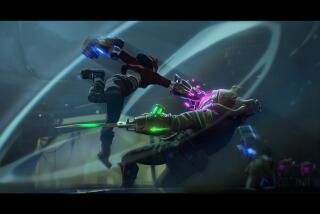How Blizzard turned a costly failure into the highly anticipated ‘Overwatch’
Blizzard Entertainment spent millions of dollars and more than five years designing a vast, ambitious video game only to realize that it wasn’t fun. The project, code-named Titan, “utterly, completely and miserably” failed, according to the guy who ran it, veteran designer Jeffrey Kaplan.
Higher-placed executives killed Titan in early 2013, long before it was ready for the general public. Kaplan felt crushed.
But Blizzard didn’t fire him. It didn’t demote him. Instead, the Irvine company put him in charge of another huge project.
This one, called “Overwatch,” is due for release this spring. It’s an unusual new shooter game, with bright, natural settings and wide-eyed, emotive characters in a genre known more for militaristic virtual venues. It also veers from the cliched lone gunman to make team-based play integral.
And if it lives up to early reviews, it could serve as a textbook case in how a strong company culture can recover from a failure while using the misfire to its advantage.
Blizzard epitomizes the overused but always important proverb that “failure is learning,” said John Smedley, former chief executive of Sony Corp.’s online gaming unit. “‘Overwatch’ is a truly revolutionary game for the first-person shooter genre, and the foundation of Titan is exactly what led them there.”
Reviewers of an early version of “Overwatch” like it. Wired, Forbes and Kotaku reviewers said they were “impressed,” “enjoying the ride,” and “as excited about a new video game” as ever. Millions of other players also are beta-testing it.
“Overwatch” pits two six-player teams on a futuristic Earth in matches that resemble parts of well-known brands “Call of Duty,” “League of Legends” and “Madden NFL.” It’s about offense and defense, strategy and camaraderie, not a race to kill the most. Mixing the right set of sly assassins, freakish hulks and other characters, given the mission and opponent, is what makes the game special.
See more of our top stories on Facebook >>
It’s too early to deem “Overwatch” a success. And Titan wasn’t nearly 25-year-old Blizzard’s only misstep. Remember “Starcraft: Ghosts”?
But no failure fell with quite the social-media-energized thud of Titan. Blizzard could swallow the cost, a fraction of nearly $600 million in operating income in the fiscal year that ended Sept. 30. What it feared was the damage to its sterling reputation.
Such a big failure might have led most wary corporate executives to quadruple-guess Kaplan. But Blizzard Chief Executive Mike Morhaime and Chief Development Officer Frank Pearce instead quickly tapped him to lead “Overwatch.” And they offered the perfect confidence booster.
“If you build it, they will come,” Morhaime told Kaplan.
The famous “Field of Dreams” quote, a movie Kaplan, 43, fondly remembers watching with his dad, was “as inspirational as it could get” for the senior vice president and “Overwatch” game director.
To the bosses, releasing a dud of a game would have been true failure and more costly. Having programmed games for much of their careers, Morhaime and Pearce respect the creative process more than “guys in suits” preoccupied by financial projections, Kaplan said. Their sympathy meant no one would be kicked to the curb.
Legacy then became a motivator too. Blizzard, a division of Santa Monica-based Activision Blizzard Inc., has a long record of producing blockbuster games, including “Starcraft II,” “World of Warcraft” and “Hearthstone.”
Proud legacy has its downsides. When the Titan project was launched in 2007, “World of Warcraft” was near peak popularity with more than 10 million paying subscribers, and a cocky Kaplan and his colleagues dismissed the challenges of recreating phenomenal success. Confidence became overconfidence, even arrogance.
But Blizzard raises a new flag outside headquarters for each game launch. Not doing so for Titan gut-checked Kaplan. With “Overwatch,” a humbler approach was called for.
“The goal was to redeem ourselves amongst our studio, among our peers,” Kaplan said.
This time, he kept the team small.
Titan numbered 150 workers. “Overwatch” has 80. Kaplan counts no magical number. Rather, he stayed tightknit enough to minimize bureaucracy and maximize individual creativity.
“You don’t want to create an army,” he said.
Another Titan lesson: Unshackle the team. The Titan crew was suffused with tension because of frustrating constraints, including most vividly a ban on virtual “flying cars.” Kaplan’s cheeky “Overwatch” response is the project’s lone arbitrary rule: Every car must fly.
That’s not to say there’s no regimen. All 80 people meet three times a week. To strengthen their common purpose, everyone plays “Overwatch” twice daily — in the morning and about 6 p.m. before going home. The next day, they regroup in small teams in their areas of expertise. Kaplan said high engagement is necessary to have people spot issues firsthand and inspire quick fixes.
Smedley, the former Sony executive, said any organization could perfect their wares by matching Blizzard’s early-testing discipline.
Blizzard has lots of people “just like me and their other customers seeing this is fun and this isn’t,” Smedley said. “By the time we see it, it’s polished as heck.”
Support even came from way up top.
When Kaplan first pitched “Overwatch” to Activision Blizzard Chief Executive Bobby Kotick, he whizzed through slides depicting characters. He figured that Kotick, who had left game development for the C-suite early in his career, cared more for business-related elements.
But Kotick slowed him down, asking to again see images of Torbjörn, a thick-bearded Swedish engineer who forges hammers.
Kotick was floored: “These are the most compelling characters I’ve ever seen,” Kaplan recalled him saying. Since that day, Kotick has talked up the game and driven to Irvine to play it. To him, the past is the past.
The widespread corporate involvement builds on Blizzard’s long-employed “strike team,” a cross-section of employees who are top-notch players and get to test products. They remain important because they lack an emotional attachment to features.
Outside the game, Blizzard is creating social media posts, graphic novels and short animated videos to develop the “Overwatch” back story. Naturally, the title jumped from game to multimedia franchise. In addition, Kaplan could leverage other departments while keeping his corps small. The video production team, for one, has produced game ideas “just as much as” his team, he said. He lends developers to other projects and other directors return the favor.
SIGN UP for the free California Inc. business newsletter >>
Feedback also has come from new sources. “Overwatch” is the first game for which Blizzard created an internal online forum, allowing the entire studio to collaborate.
The collegial spirit has spread. Blizzard’s quality assurance testers focus on certain games but constitute a separate department. Kaplan, though, included the 14 “Overwatch” testers in his team meetings to the point where there was little separation.
So when quality assurance managers gave “Overwatch” testers cash to party, the testers organized an internal tournament for the game for the entire development team, buying pizza and beers for the championship.
The small act had big consequences. The tournament revealed design flaws and proved the game would be great for competitions. And Kaplan came away encouraged that the testers took on the culture of doing more with less.
Chris Metzen, Blizzard’s senior vice president for story and franchise development, said last month that the “Overwatch” approach re-instilled companywide “appreciation” for smaller projects. That’s a good thought to help Blizzard save face after Titan, but the 22-year Blizzard veteran insisted that there’s been remarkable “geeking out.”
“It’s the coolest time to be at this place,” Metzen said.
Twitter: @peard33
ALSO
Games in 2015 were better when they stepped away from the guns
Super Evil Megacorp sees big potential in eSports for mobile game ‘Vainglory’
Do modern console games coddle current players rather than court new ones?







